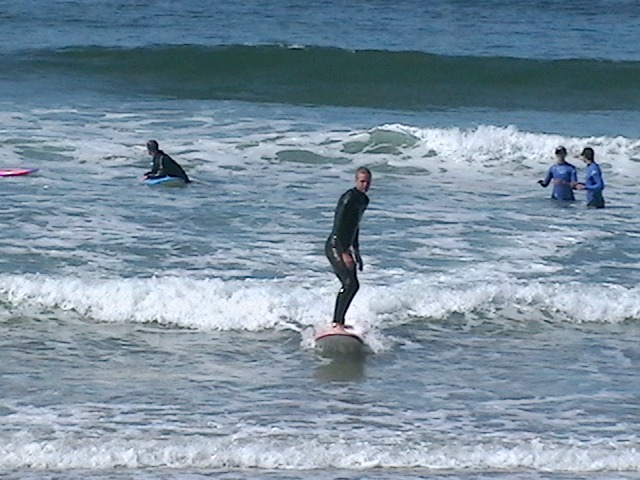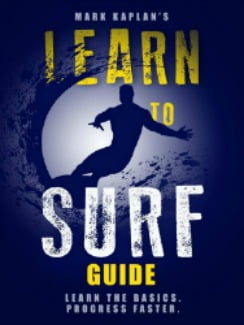Surf timing for catching foam waves will serve beginners when they begin to surf real waves. Beginner surfers learn the timing of catching waves, doing pop ups and riding to the beach.
The ease of catching a foam wave is that it can be seen for a long time before it arrives. Even then, beginners often can’t figure out when to get in front and many don’t realize they need to get in front of it.

Timing Foam Waves
I suggest to students they let the foam wave get within 15-20′ then roll over on the surf board. I like the timing of three easy paddles that get the board moving and then three hard paddles that accelerate the surf board in front of the wave.
Getting in front of the foam wave makes the pop up easy. Many beginners without lessons are popping up before the foam wave hits the board. Most beginners want to put their hands on the board before they have gotten in front of it.
If the surf board tail is in the foam when the surfer tries to stand up, the board is much more unstable. If the surf board is in front of the wave when the surfer puts his hands on the board, the board is stable.
Doing the Pop Up on a Foam Wave
I suggest to students to get in the rhythm of three easy paddles and then three hard paddles to catch the foam wave. The first thing after that is put the hands on the surf board in a man’s push up position.
In catching foam or real waves the board accelerates when the wave has the board. The surfer needs to stop their momentum to do a pop up or they catapult over the nose of the board. Putting their hands on the board to rest for a second before pushing up stops the surfer’s forward momentum. Then they can do their pop up into the right posture.
Beginners make the mistake of paddling and then putting their hands on the board already extended so they are at the top of the push up or in a down dog position in yoga. This makes it difficult to get the feet under the body properly and usually results in the surfer flying over the front of the board.
Catching Real Waves
Once the surfer has mastered catching foam waves and riding to the beach, I have students paddle out through the waves and turn around to catch bigger foam waves and start looking for small real waves.
The timing is pretty close except that a real wave arcs and the surfer has to be in front of that arc and moving before it arrives. The student does the same timing with putting their hands on the board in the man’s push up position and then executing their pop up.
I tell students to treat all waves the same. Get in front of the wave and execute the pop up smoothly. New surfers usually panic when they feel the speed of a real wave until they learn to calm down and execute the same pop up they used catching foam waves.
Learn More
My New Surfing Course in an E-Book plus Demo Video or Audio Version
Get the 18 Chapter, 7,500 word Course that can prepare you for a lesson or give you the fundamentals if you are going to try it on your own. 10 years of teaching 350 students a year has given me the insights on the most precise measures you must follow for success. This course is what I teach on the dry land and in water instruction. The Course includes a 15 minute video on my dry land and in water demonstration. Only $4.95
Buy the E-Book and start learning $2.99. Learn to Surf
Buy the Paperback on Amazon $7.95
Get Learn to Surf Course in 29 minute AUDIO. Great prep for a lesson, reviewing after a lesson, learning on your own, refreshing after not having surfed for a while. See Table of Contents. Only $7.95.

For Oceanside Surf Lessons, see the Home Page
See the Post Search Lessons Teach Fundamentals
See the Post Catching Real Surf Waves
See my Dry Land and in Water Demo video
See my other Surf site for more Posts
I have lowered the price of Courses and Books for the lock down price of $2.99
80 page Learn to Surf Book
![Surf Instructions Beginner to Advanced: Learn to Ride Waves by [Kaplan, Mark]](https://images-na.ssl-images-amazon.com/images/I/51HswFtoBQL.jpg)